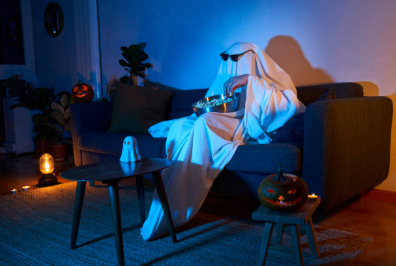Fear is one of the oldest tools in storytelling.
Whether it’s the primal dread of the unknown or the creeping anxiety that comes from recognizing ourselves in something terrible, horror films continue to evolve with each generation.
Four movies, Sinister (2012), The Conjuring (2013), Sleepy Hollow (1999), and Parasite (2019), each present fear through different lenses, blending supernatural, psychological, and social terror to remind audiences that horror is not just about what lurks in the dark, but about what hides within humanity itself.
Few films capture dread quite like Sinister. Directed by Scott Derrickson, it follows true-crime writer Ellison Oswalt, who discovers a box of home videos depicting gruesome murders.
The fear here is not born from jump scares or gore, but from the film’s suffocating atmosphere. The grainy “Super 8” footage acts as a window into something ancient and malicious, represented by the demon Bughuul.
Unlike many horror villains, Bughuul doesn’t simply haunt or kill; he consumes souls, particularly those of children.
What makes Sinister effective is its manipulation of realism. The story feels plausible at first.
A writer obsessed with finding his next big story moves his family into a murder house. But the longer he investigates, the more he, and we, descend into the abyss of obsession and self-destruction.
The film’s horror lies in its inevitability. Every piece of evidence pushes Ellison closer to his doom, yet he keeps watching.
The true terror of Sinister is not just in what the tapes show, but in the idea that curiosity itself can destroy you.
Where Sinister isolates a man in his personal darkness, The Conjuring directs its fear outward, toward family and faith.
Based on the real-life case files of paranormal investigators Ed and Lorraine Warren, the film grounds its supernatural horror in human warmth. The Perron family, plagued by a malevolent spirit, serves as the emotional core.
“Id say through the ambiance and how the horror is created through the set up, and that doesn’t really stick to a specific genre,” Kutter O’Brian said.
Their love and vulnerability make every creaking door and whispered voice more impactful because we care about them.
Director James Wan crafts fear through rhythm and restraint. The pacing mirrors an exorcism: tension builds gradually, punctuated by moments of release that only make the next scare worse.
Wan avoids excessive CGI or gore, instead focusing on sound and suggestion. the knockings, the shadows, the unseen presence that feels inches away.
But the most significant theme in The Conjuring is faith, not only religious faith, but faith in each other.
Ed and Lorraine’s partnership contrasts sharply with the isolation of Sinister.
Their strength lies in unity, and the film’s message becomes clear: evil feeds on division, but belief, love, and trust can overcome it.
It’s a classic yet deeply comforting form of horror, reminding audiences that courage and compassion are themselves supernatural forces.
Tim Burton’s Sleepy Hollow reintroduces a familiar legend. the Headless Horseman; but infuses it with style and melancholy. Unlike the modern horrors of Sinister and The Conjuring, Sleepy Hollow thrives on a gothic atmosphere: mist-shrouded forests, flickering candles, and blood as bright as paint.
Burton’s approach is both homage and critique, blending 18th-century superstition with modern skepticism.
Ichabod Crane, portrayed by Johnny Depp, represents the Age of Reason—a man of science sent to investigate irrational death. His faith in logic crumbles as he’s confronted with undeniable evil. This collision of reason and superstition creates an elegant kind of fear: the terror of realizing that logic doesn’t always protect us.
Burton’s world is one where beauty and horror coexist, where the grotesque is strangely poetic. Unlike the raw terror of Sinister or the spiritual warfare of The Conjuring, Sleepy Hollow terrifies through style and symbolism.
It reminds us that horror can also be art, a mirror reflecting the fragility of human reason in a world ruled by forces we can’t understand.
While Parasite may not fit neatly into the horror genre, it captures one of its most disturbing truths: real life can be far scarier than ghosts. Bong Joon-ho’s Oscar-winning masterpiece is a dark satire about class division, but beneath its humor and social commentary lies a structure as tight and suspenseful as any horror film.
The Kim family infiltrates the wealthy Park household, and at first, it feels almost like a heist film. But the tension steadily builds until it erupts into chaos.
“I like context though I’m not a huge fan of gore, but watching things fall into place, is what gets me on the edge of my seat,” Bella Aldrich said.
The horror of Parasite is not supernatural, it’s systemic. The “monster” here is inequality itself, an invisible force that pits people against one another in desperation.
The film’s basement scene, where the family discovers the secret bunker beneath the Park home, serves as its gothic heart. A literal underworld hidden beneath luxury.
Bong Joon-ho transforms economic despair into psychological horror, showing how far people will go to survive.
The violence that follows feels inevitable, not because of evil spirits, but because of social design. Parasite is a reminder that sometimes the scariest ghosts are made of flesh and blood.
Each of these films, Sinister, The Conjuring, Sleepy Hollow, and Parasite, explores fear through a different dimension. The personal, the spiritual, the mythical, and the social. Together, they illustrate that horror is not confined to one form or formula. It can haunt our homes, our beliefs, our minds, and our societies.
What unites them is a shared truth: fear exposes vulnerability. Whether it’s a writer undone by his own obsession, a family fighting for their souls, a skeptic facing the supernatural, or a poor family clawing at the walls of privilege, each story reflects humanity’s deepest anxieties.
